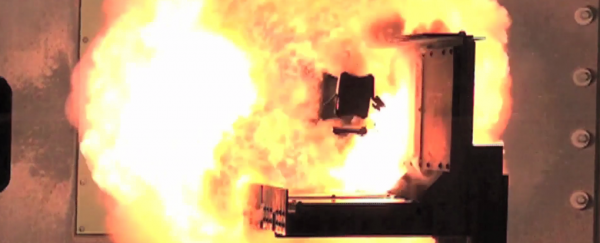Railguns sound like the stuff of science fiction. Instead of using chemical propellants, or explosives, these cannons use only electromagnetic force, and can shoot projectiles at speeds up to 8,500 kilometres per hour, or 2,300 metres per second.
They have been more than half-a-century in the making, and while the premise is relatively simple, the engineering behind these futuristic weapons is complex - they require an enormous amount of power and a design that can withstand extreme forces.
Several development efforts have been hindered by funding restraints, turf wars and overinflated results, but research has continued - largely funded by space agencies, which are interested in the potential of railguns for launching small spacecraft, and military agencies, which, you know, want to scare people with crazy, badass weapons.
Now, for the first time, the US Navy has announced that it will deploy and test a full-scale railgun on one of its Joint High-Speed Vessels, the USNS Millinocket, in 2016.
"We've demonstrated that if you built it big enough, you can fire it, and it works," Roger Ellis from the US Office of Naval Research told IEEE Spectrum.
The US Navy's prototype, developed by engineering firm BAE Systems, is pretty impressive. According to Evan Ackerman over at IEEE Spectrum, "in just 10 milliseconds … [the prototype] accelerates projectiles to between Mach 6 and Mach 7 (8,500 kilometers per hour) with 32 megajoules of energy, resulting in a range of just over 200 kilometers. This far surpasses conventional naval weapons."
The below video from BAE Systems shows footage of the US Navy's railgun prototype in slow-motion action.
So how does the gun fire projectiles at such blistering speeds?
Science writer Carolyn Meinel describes how railguns work for IEEE Spectrum:
"A railgun has few parts: a pair of parallel conducting rails inside a barrel, an armature that rides the rails, and a projectile in front of the armature. A jolt of dc current applied to one rail will travel up it, across the armature, and down its mate, completing a circuit and filling the gun's barrel with an intense magnetic field.
"The barrel contains the pressure of this field, known as the Lorentz force, and so the only part that can yield to the pressure is the movable armature. The armature shoots out of the barrel, along with the projectile, at speeds as high as tens or even hundreds of kilometers per second—at least in theory. The most powerful conventional gun, by contrast, maxes out at about 2 km/s (about 4500 miles per hour)."
The US Navy says there are two key advantages to railguns: cost and safety. There's no explosive components in the projectiles - they're essentially just hunks of missile-shaped metal. This makes them safer for personnel to handle and store. It also makes them significantly cheaper to produce than conventional missiles loaded with explosives. And according to the US Navy press release: "against specific threats, the cost per engagement is orders of magnitude less expensive than comparable missile engagements."
Ellis told IEEE Spectrum that the next iteration of the railgun will feature guidance technology on projectiles, an autoloader on the back (as opposed to a human loader) and a system that allows the gun to recharge and fire multiple rounds per minute.
And really, that's all we need, right? A rapid fire railgun. We'll be keeping watch for future tests. And taking cover.
Source: IEEE Spectrum
